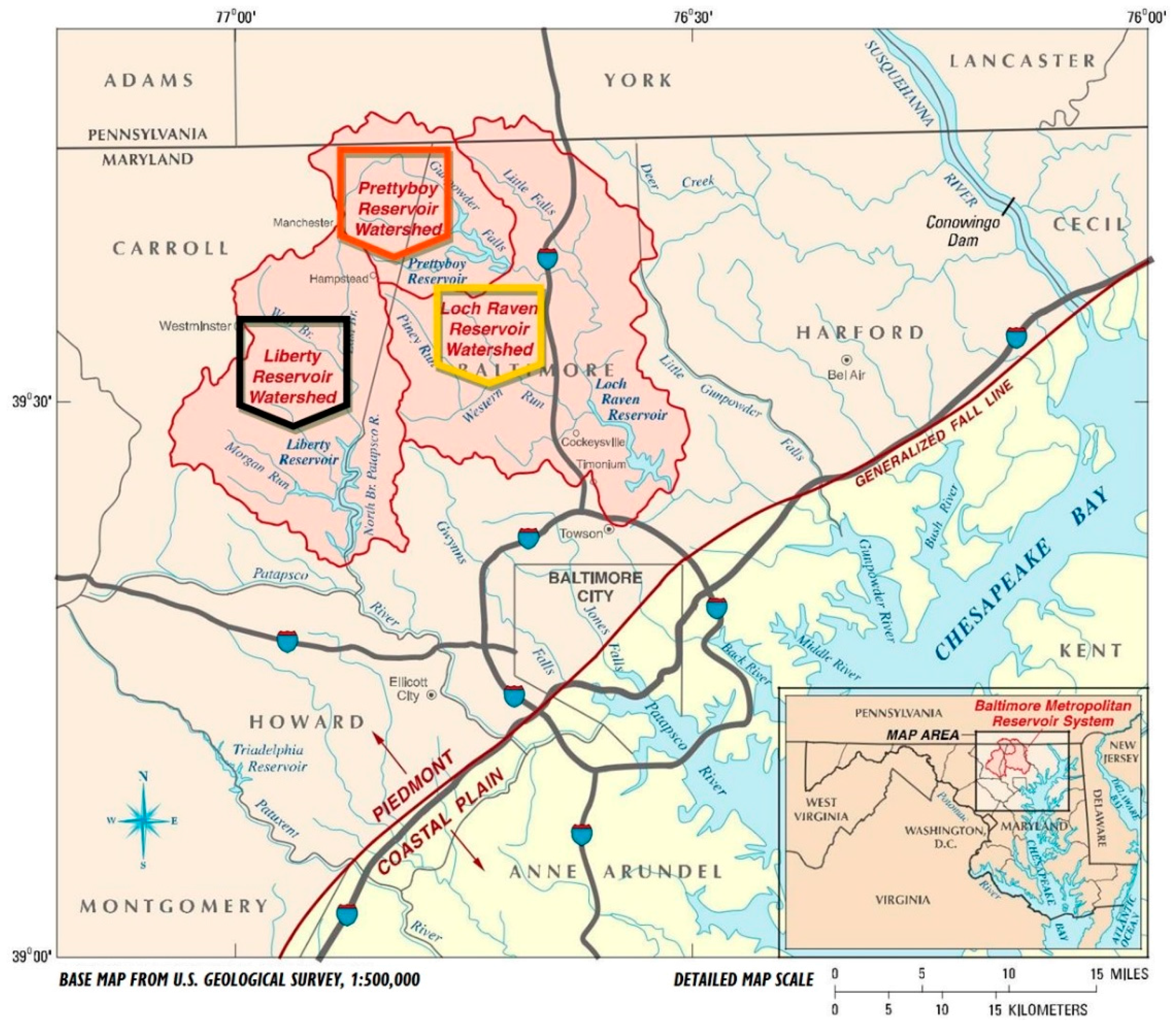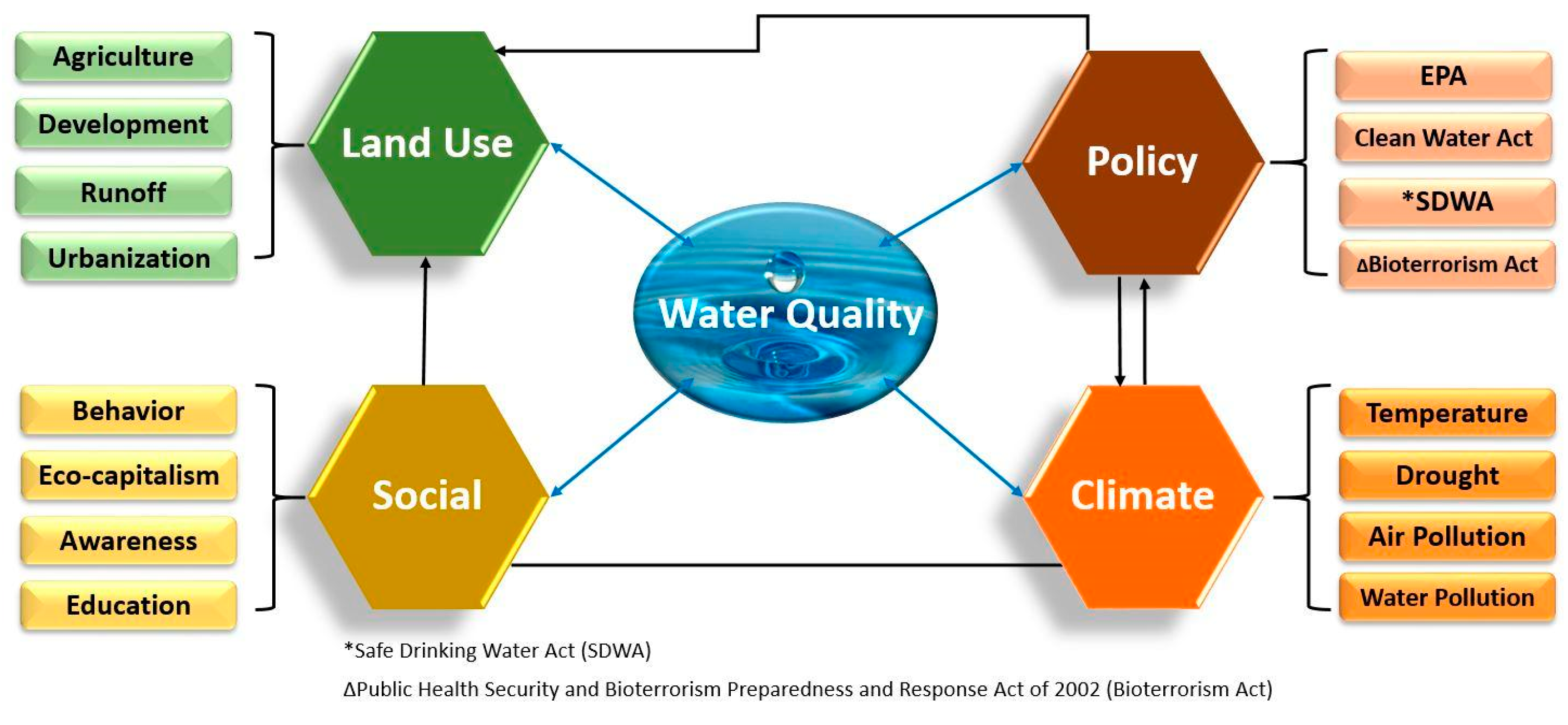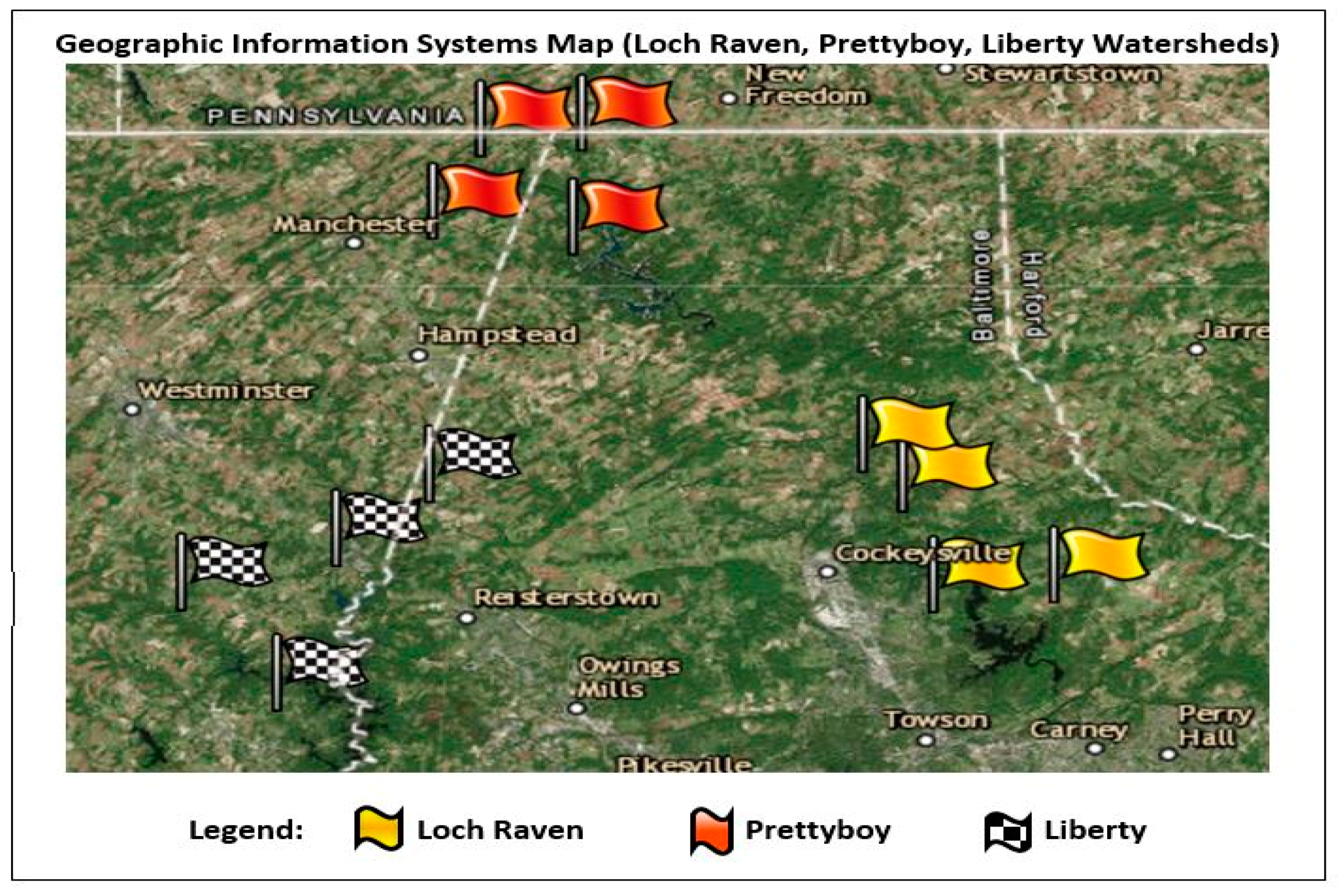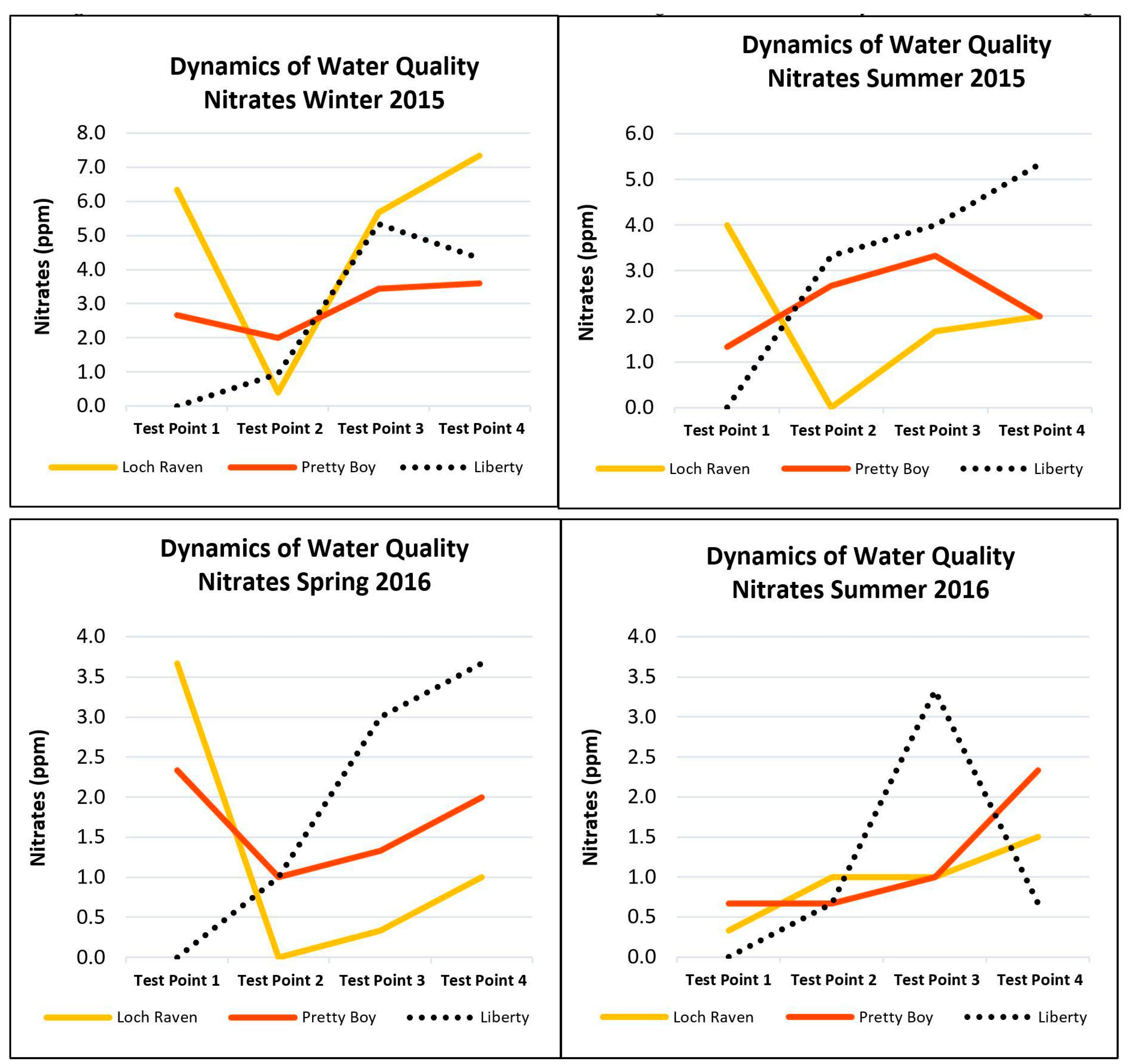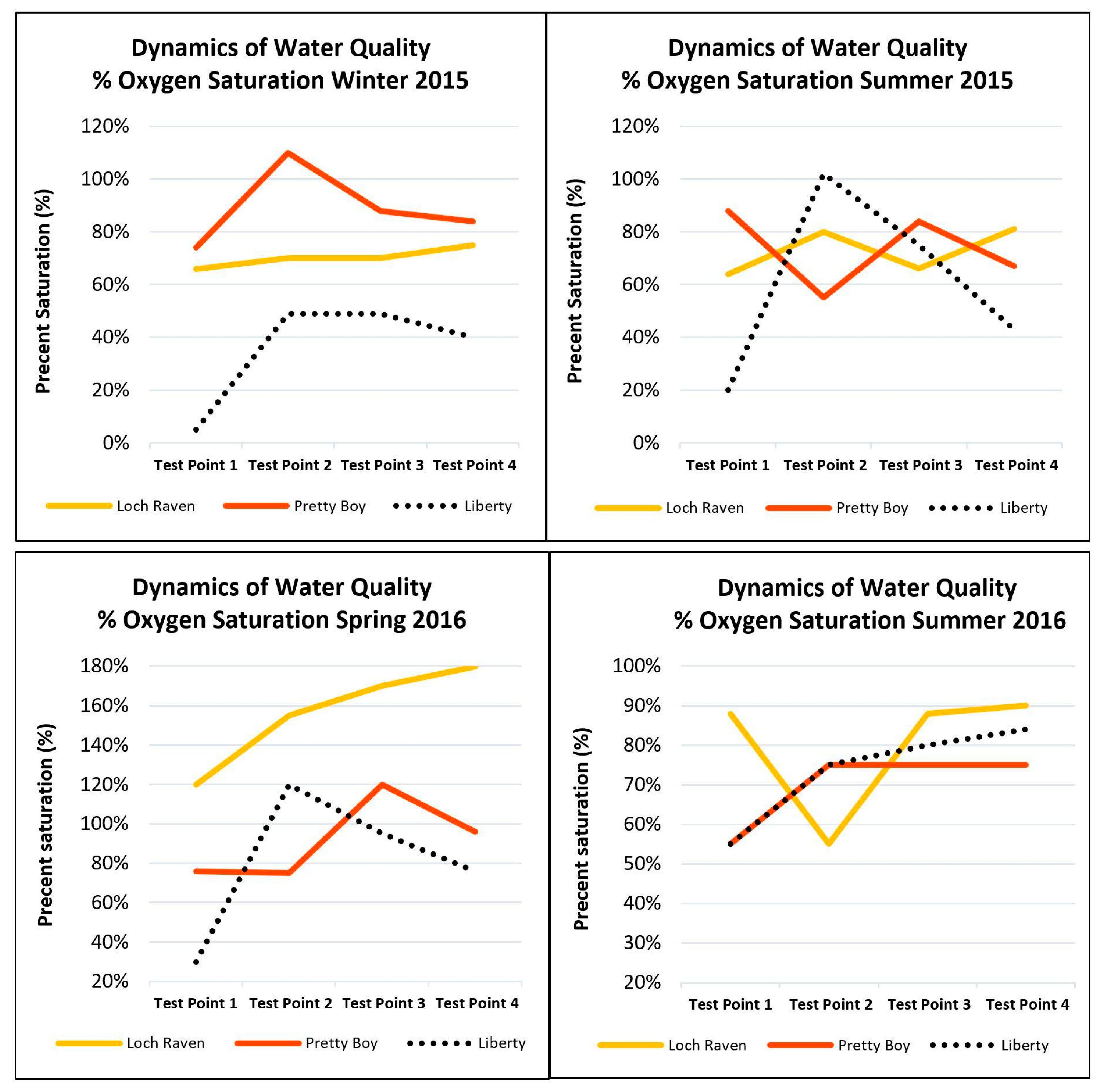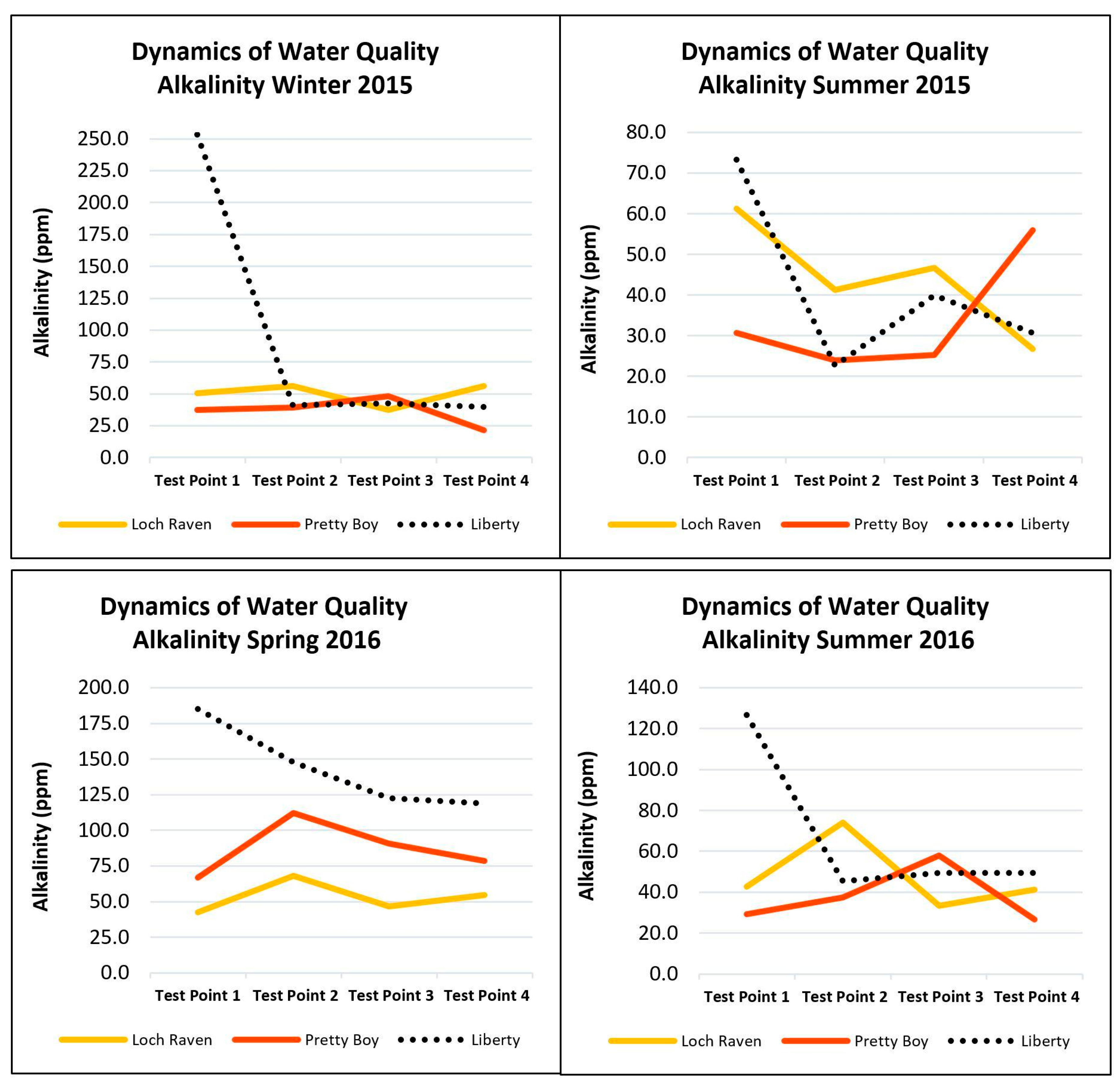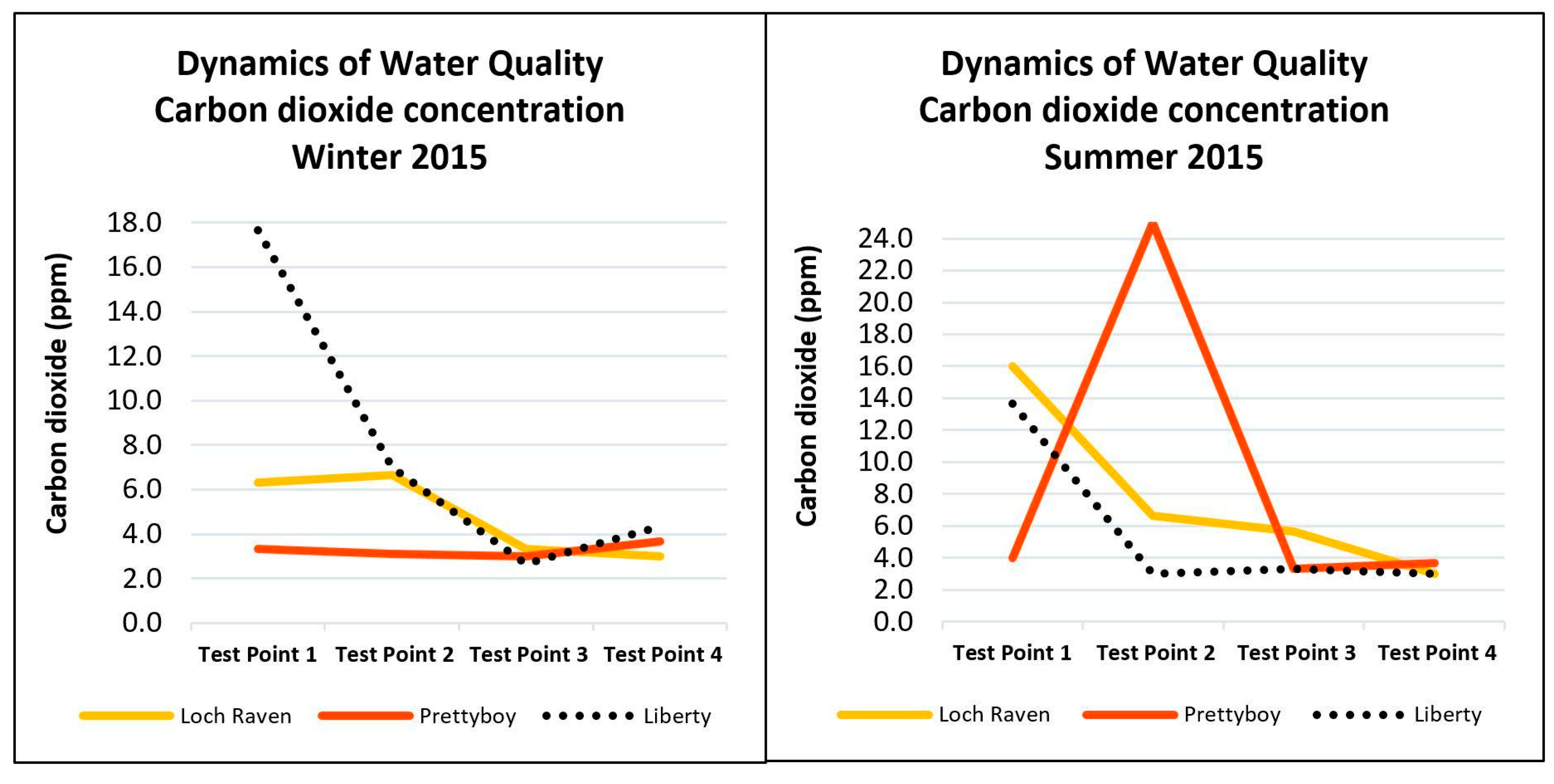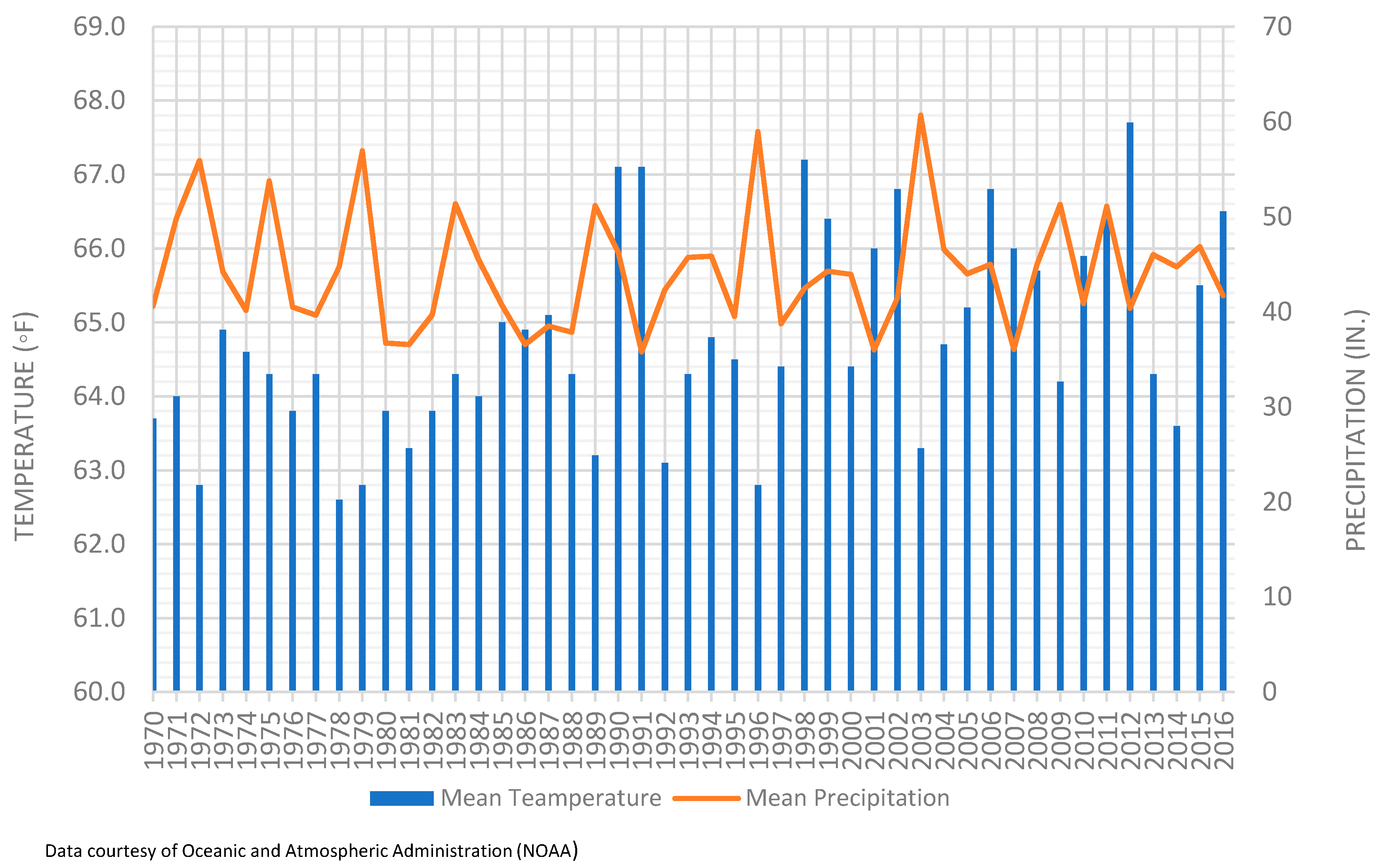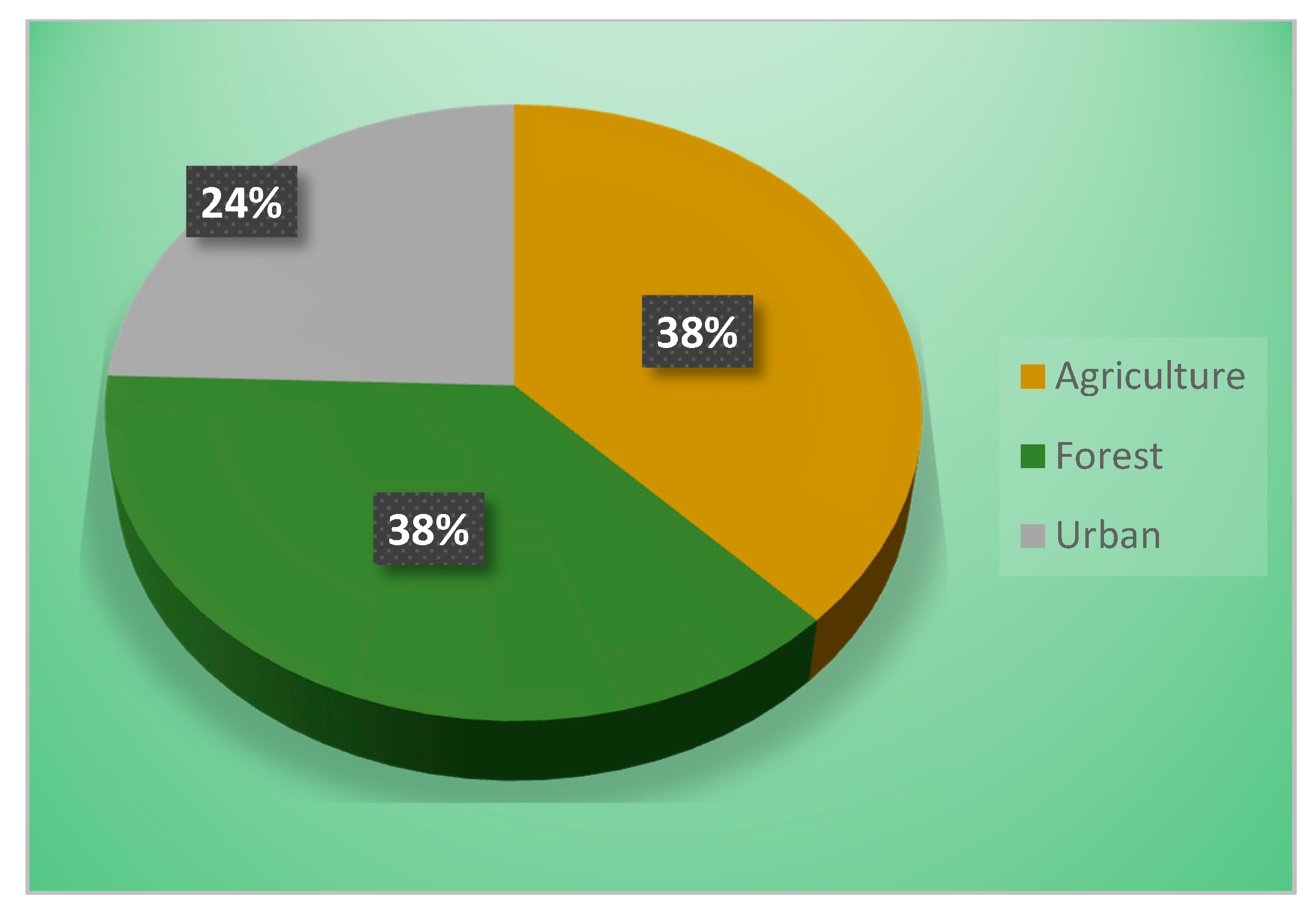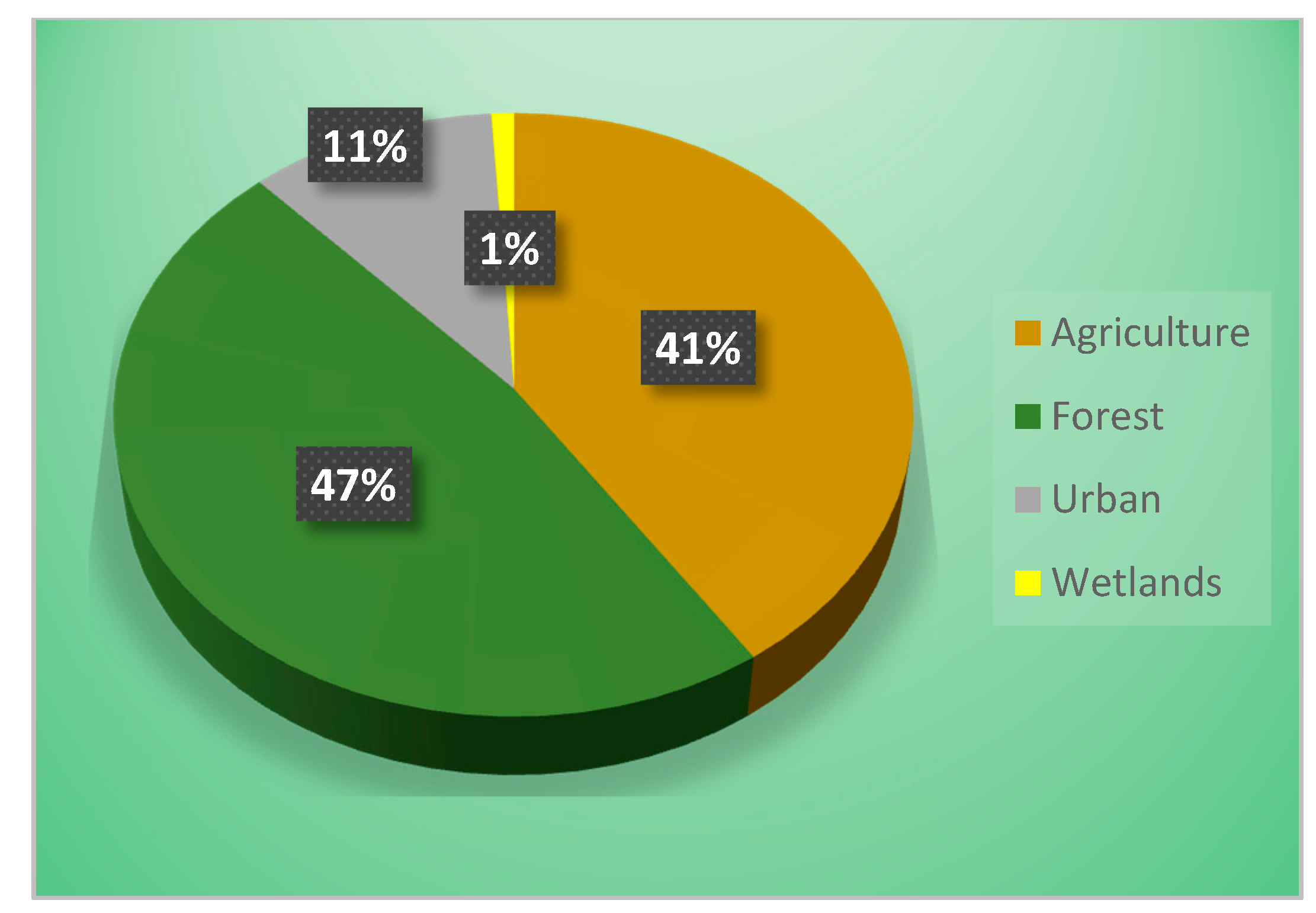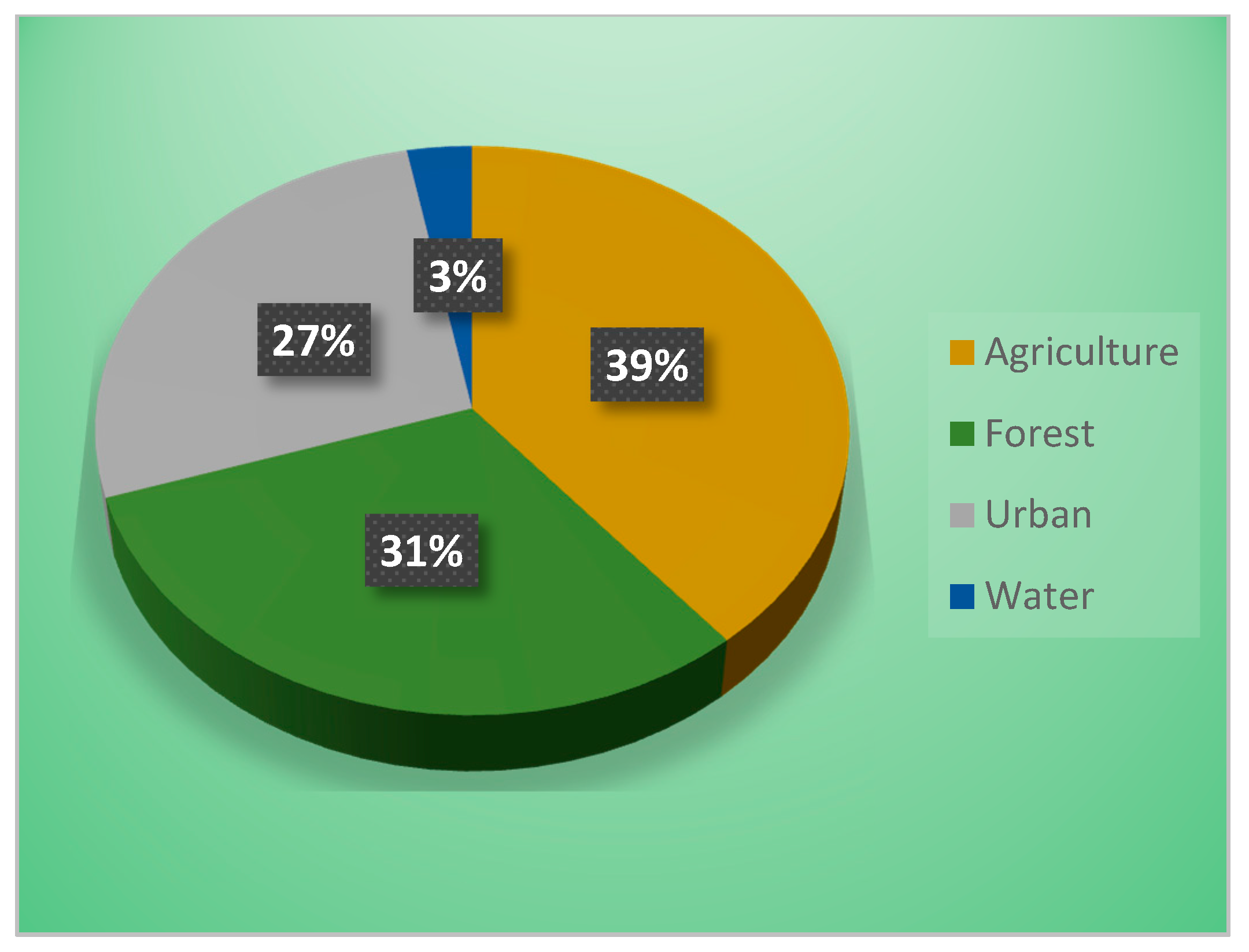1. Introduction
At a global scale, water resources have proven themselves to be resilient to natural and man-made threats. Growing population’s need for water is increasingly competing with nature’s own demands for water to sustain already imperiled ecosystems and the services upon which all living organisms depend. Clean water has become scarce and will become even scarcer with the onset of climate change.
Water quality is commonly defined by its physical, chemical, biological and aesthetic characteristics. A healthy environment is one in which the water quality supports a rich and varied community of organisms and public health. “An emerging water quality concern in many watersheds is the impact of personal care products and pharmaceuticals, such as birth control pills, painkillers, antidepressants and antibiotics, on aquatic ecosystems” [
1]. In this context, the current study posed a question, “How is Baltimore’s water quality?” Baltimore City supplies drinking water to 1.8 million homes including parts of Anne Arundel, Baltimore, Carroll, Harford and Howard counties. A long-term water-quality study by United States Geological Survey (USGS) [
2] raised concerns that include eutrophication and sedimentation in the reservoirs. It found elevated concentrations of (a) nutrients (nitrogen and phosphorus) being transported from the major tributaries to the reservoirs; (b) iron and manganese released from reservoir bed sediments during periods of deep-water anoxia; (c) mercury in higher trophic order game fish in the reservoirs; and (d) bacteria in selected reservoir watershed tributaries. Emerging concerns included elevated concentrations of sodium, chloride, and disinfection by-products (DBPs) in the drinking water from both (Liberty and Loch Raven) supply reservoirs. Climate change is also an emerging concern, affecting seasonal weather patterns and drought occurrence, which historically have led to declines in reservoir water quality [
2].
A study by Tambe et al. discussed a community in South Asia where half the time the available drinking-water was contaminated with faecal organisms [
3]. Although 85% of drinking-water in South Asia meets the target of the Millennium Development Goal of coming from an improved source, this contamination is still common. In the United States, at the beginning of the twentieth century, most large- scale municipal water districts distributed untreated water. Immediately following the introduction of effective water treatment, overall child mortality dropped by 46% in major US cities [
4].
In Baltimore city, accepted standards of clean water are: (a) pathogen-free; (b) softened if the raw water has a high mineral content; and (c) free of harmful or unwanted chemicals and decaying matter. Treated water has chlorine to prevent the growth of microorganisms, lime to prevent corrosion of the pipes through which water flows, and fluoride to prevent tooth decay. Various city reports suggest that the drinking water meets all federal water safety standards. Baltimore’s 2013 water quality report, however, shows the chlorine by-products hover right below the legal limit. Scientific research suggests that long-term exposure to chlorine by-products through drinking, inhalation or cutaneous absorption (hot showers) is linked to higher bladder cancer rates in exposed human populations [
5].
This study examines social and bio-chemical factors that potentially cause water quality impairment in Baltimore’s watershed. We used the Socio- Environmental Synthesis (SES) approach, which combines insights, methods and data from the natural and social sciences to produce knowledge and generate solutions [
6]. Long-term water quality data was obtained from secondary sources and seasonal changes in water quality were analyzed both in the lab and field (described in the methods section). The Baltimore Ecosystems Study (BES), using the watershed ecosystems approach, undertook a large-scale study in Baltimore’s watershed to understand the linkages and feedbacks between the social and bio-physical components of the system and to contribute knowledge of integrated socio-ecological landscapes to the ongoing efforts to improve the quality of water draining into the Chesapeake Bay [
7]. The current study is complimentary to the BES and seeks to improve our understanding of Baltimore’s three watersheds.
4. Discussion
Environmental problems are complex and encompass various natural, economic and social dimensions [
10]. As one critical component of the environmental problems, water quality issues are intricate to study as there are a number of factors that attribute to its impairment. These factors range from biophysical to sociopolitical issues. As such, there are limited research approaches that provide a comprehensive analysis and synthesis of these factors to layout a strategic and sustainable intervention. According to the National Socio-environmental Synthesis Center [
6], “it is time that we dramatically broaden the community of scholars who tackle environmental problems by going well beyond the natural sciences and even beyond the social science fields that are now within the collaborative comfort zone of environmental scientists (e.g., economics). This means figuring out how to collaborate across disciplines that use very different methods from those that most natural scientists are accustomed to, including, for example, branches of psychology or sociology”.
In this study, four essential components of water quality that are integrally related were identified and defined as “dimensions”. As can be seen from
Figure 9, the mean temperature in the study area slightly increased over the last 45 years causing a possible impairment in the quality of water. A similar study on the effects of climate change on surface water quality [
20] found out that “the combination of higher surface water and increased nutrient loading from agricultural runoff contributes to harmful algae blooms that produce bio-toxins”. Another study on the impacts of climate change on lakes in the Netherlands revealed, “climate change favors and stabilizes cyanobacterial dominance in phytoplankton communities and cause more serious incidents of botulism among waterfowl and enhance the spreading of mosquito borne diseases” [
21].
Data from long-term ecosystem monitoring and research stations in North America and results of simulations made with interpretive models indicate that changes in climate (precipitation and temperature) can have a significant effect on the quality of surface waters. Changes in water quality during storms, snowmelt, and periods of elevated air temperature or drought can cause conditions that exceed thresholds of ecosystem tolerance and, thus, lead to water-quality degradation [
22].
It has been widely accepted that there is a close relationship between land use type and water quality. A study conducted on “urbanization, land use, and water quality in Shanghai: 1947–1996” [
21] revealed that rapid urbanization corresponds with rapid degradation of water quality. It also indicates that urban land uses are positively correlated with the decline in water quality. A regression model shows that close to 94% of the variability in water quality classifications is explained by industrial land area.
Four water quality indicators were used in the study (nitrate, alkalinity, percent oxygen saturation and carbon dioxide) to assess the seasonal changes in water quality in the three watersheds. Comparison based on mean average revealed that the nitrate levels in all three watersheds is below the maximum EPA allowed contaminant threshold (10 mg/L). Water quality monitoring in Pennsylvania showed that nitrate is present throughout much of the state at relatively low concentrations, but in areas of intense farming, the nitrate-nitrogen concentration may approach or exceed the World Health Organization (WHO) drinking water limit of 10 mg/L [
23]. In addition, there are isolated cases where the concentration of nitrate-nitrogen down-gradient of large volume on-site wastewater disposal sites, septic/solids disposal, and landfills may exceed the drinking water limit. Nitrate contamination studies in Austria [
24] showed higher average temperatures result to lower nitrate contamination, possibly due to increased evapotranspiration. Higher average precipitation rates dilute nitrates in the soil, further reducing nitrate concentration.
Alkalinity monitoring in the study area revealed measurements within the optimum alkalinity levels ranging between 20 and 63 ppm except Liberty (test point 1), which consistently showed very high values (73 ppm, 126.7 ppm and 253 ppm) during the three seasons (winter, summer and spring). This test point is located alongside a construction area where some effluents may enter into the streams. Mean average comparison of alkalinity levels across seasons shows highest concentration (94 ppm) during winter in 2015 at the Liberty watershed and the lowest levels (33 ppm) at Prettyboy during summer. In 2016, the highest was during spring at Liberty (68 ppm), with the lowest levels (34 ppm) at Prettyboy during winter. Alkalinity level monitoring in Pennsylvania found 20 ppm to be the minimum level to protect aquatic life [
25]. Another study in Massachusetts determined the desirable alkalinity range for irrigation water to be 0 to 100 ppm calcium carbonate. Levels between 30 and 60 ppm are considered optimum for most plants [
26].
In order to study the biological activity in the watersheds, Biological Oxygen Demand (BOD) was monitored. BOD is a measure of the oxygen used by microorganisms to decompose waste. The results showed a mean average comparison of oxygen saturation levels across seasons shows the highest percentage (73%) during winter 2015 at the Prettyboy watershed, with the lowest (36%) at Liberty during winter. In 2016, the highest was during spring at Lock Raven (134%), with the lowest (70%) at Prettyboy during the summer. The Cary Institute’s modified water quality index was used to classify the BOD measured data and concluded that percentage values below 60% are considered poor quality, 60–79% acceptable for most stream animals, 80–125% excellent for most stream animals and 125% or more too high for any stream animal.
A similar study in India concluded, “Environmental impact of total dissolved solids gas concentration in water should not exceed 110% (above 13–14 mg/L). Concentration above this level can be harmful to aquatic life. Fish in waters containing excessive dissolved gases may suffer from “gas bubble disease” [
16]. Another study [
15] in Korea used a threshold of 33.4% (4 mg/L) as a minimum BOD value to determine the suitability of their study sites. This shows the threshold values generally vary depending on the specific sites.
Carbon dioxide was monitored over different seasons within the study area. Mean average comparison of the carbon dioxide levels across seasons shows the highest percentage during summer 2015 at the Prettyboy watershed (8.9 ppm), with the lowest at Prettyboy (3.2 ppm) during winter of the same year. In 2016, the highest level was recorded during the summer at Prettyboy (10.8 ppm) and the lowest carbon dioxide level was recorded (2.2 ppm) at Liberty during spring. According to EPA guidelines, surface waters contain less than 10 ppm free carbon dioxide while ground waters may have much higher concentrations. All test points in the study sites are within or close to this limit, ensuring good quality for aquatic life.
5. Conclusions
This paper demonstrated how the Socio-Environmental Synthesis (SES) approach is used as a method to understand holistic causes of water quality deterioration. SES integrates existing knowledge and data from natural and social sciences to advance understanding of complex socio-environmental systems [
4]. The SES approach explored the underlying socio-environmental and bio-physical causes of water quality deterioration in three Baltimore watersheds that supply drinking water for the residents of Baltimore City. As a result, four important dimensions of water quality were identified: land use, climate, social behavior and governmental policies and studied how these dimensions contribute to a deterioration in water quality.
The report also found that urbanization and agriculture have been the two major threats to watershed health. The loss of vegetation due to urbanization and agriculture decreases the effectiveness of the natural filtration system, resulting in the degradation of raw water quality. In addition to natural waterway contamination, runoff from urban and agricultural settlements, concrete drains, muddy and polluted water also contribute to decreased overall water quality [
2]. Changes in the land cover and land management practices have been regarded as the key influencing factors behind the alteration of the hydrological systems, which eventually lead to changes in water quality [
8,
10]. To understand the long-term impacts of land use changes, previous water quality study reports (Baltimore water quality monitoring report, 1981–2007) were used and did seasonal testing on select water quality characteristics in the three watersheds. Nitrate-nitrogen, BOD, alkalinity and carbon dioxide concentration were monitored over different seasons during 2015–2016 and comparisons between seasons and amongst study sites using mean averages were conducted.
The study revealed that, while the quality of the drinking water meets or exceeds EPA standards, there is a growing concern in the quality of water in the watersheds. The high levels of nitrate-nitrogen and increased concentrations of carbon dioxide are especially alarming. The high level of BOD is a good indicator of the intensity of agricultural and urbanization increase over time. A study by Ouyanga et al. has shown that human impacts from urbanization include forest cover loss, an increase in impervious surfaces, and an increase in storm run-off [
16].
Climate change and increasing population pressure places an imminent threat to water quality and protecting watersheds would significantly reduce the cost of water treatment. Analysis of 20 years of temperature and precipitation data has shown that there is a correlation between increased temperature and higher levels of BOD and carbon dioxide concentration. Watershed degradation has influenced the cost of water treatment in about one-third of large cities globally, increasing those costs by about half [
25]. This increase in water treatment costs borne by local taxpayers has had a real quantitative cost to hundreds of millions of urbanites. In summary, watershed conservation and restoration should be an important priority to safeguard urban water supplies.
